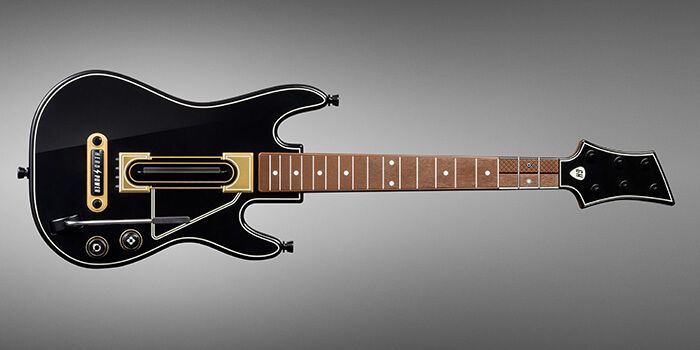It's 2007 all over again. Hot on the heels of the news that Harmonix is hard at work on a new installment of Rock Band, Activision just announced Guitar Hero Live, reviving the two series' almost decade-long rivalry.
However, while Rock Band 4 looks like it'll do things traditionally, refining the tried and true formula that made the franchise so popular in the first place, Guitar Hero Live rebuilds the peripheral-based music game from the ground up. Yes, players still will use a plastic guitar to match "notes" streaming down the screen, but almost everything else about the game is brand new. There's the first-person perspective, of course, which uses prerecorded footage to simulate a real-life concert; more surprisingly, Guitar Hero Live also uses a completely new controller.
Previously, Guitar Hero and Rock Band controllers had five buttons, evenly spaced on the neck of a plastic guitar. Since most people only have four fingers (plus a thumb, which was used to hold the device), players had to slide their hands up and down the neck in order to hit the right buttons at the right time.
Guitar Hero Live introduces a brand new mechanic: this time, there are six buttons on the controller, but they're stacked on top of each other, making two rows of three buttons each. As a result, players only need three fingers to cover the entire controller. Movement is unnecessary.
Guitar Hero Live's new controller came about for two reasons. For one, while players won't move up and down the neck of the guitar any more, Guitar Hero Live will ask them to press multiple buttons - including ones on different rows - at the same time, better simulating chords (after all, most guitarists don't just hit single notes). Secondly, players don't need to use their pinky fingers at all. Developer FreeStyle Games found that, even at advanced levels, players struggled to move their pinky fast enough to hit notes in time. As such, the new controller should make the Guitar Hero Live easier to play while making it feel realistic, too.
The Guitar Hero interface is changing to accommodate the new guitars, too. Now, only three tracks of notes move down the screen. The color-coded bars are gone; now, each note is either black or white, corresponding to the top or bottom row of buttons, respectively. This change makes Guitar Hero Live much cleaner and easier to follow; after all, the challenge should come from hitting the right buttons at the right time, not deciphering a confusing interface.
Of course, all this innovation comes at a price: unlike Rock Band 4, which is backwards compatible with the older peripherals, Guitar Hero Live users will need to purchase a new guitar if they want to play the game. A bundle with both the game and Guitar Hero Live's new peripheral will cost about $100.
Guitar Hero Live is expected in late 2015. Platforms have not yet been announced.
Source: Engadget

